Anaerobic Carbon Monoxide Uptake by Microbial Communities in Volcanic Deposits at Different Stages of Successional Development on O-yama Volcano, Miyake-jima, Japan
Abstract
1. Introduction
2. Materials and Methods
2.1. Site Descriptions, Sample Collection and Processing
2.2. CO Uptake Assays
2.3. Soil Analyses
2.4. DNA Extraction, Sequencing and Analysis
2.5. Statistical Analyses
3. Results
3.1. CO Uptake
3.2. Microbial Community Analysis
4. Discussion
Supplementary Materials
Author Contributions
Funding
Conflicts of Interest
References
- King, G.M. Contributions of Atmospheric CO and Hydrogen Uptake to Microbial Dynamics on Recent Hawaiian Volcanic Deposits. Appl. Environ. Microbiol. 2003, 69, 4067–4075. [Google Scholar] [CrossRef] [PubMed]
- Fujimura, R.; Kim, S.-W.; Sato, Y.; Oshima, K.; Hattori, M.; Kamijo, T.; Ohta, H. Unique pioneer microbial communities exposed to volcanic sulfur dioxide. Sci. Rep. 2016, 6, 19687. [Google Scholar] [CrossRef] [PubMed]
- King, G.M.; Weber, C.F.; Nanba, K.; Sato, Y.; Ohta, H. Atmospheric CO and Hydrogen Uptake and CO Oxidizer Phylogeny for Miyake-jima, Japan Volcanic Deposits. Microbes Environ. 2008, 23, 299–305. [Google Scholar] [CrossRef] [PubMed]
- Ji, M.; Greening, C.; VanWonterghem, I.; Carere, C.R.; Bay, S.K.; Steen, J.A.; Montgomery, K.; Lines, T.; Beardall, J.; Van Dorst, J.; et al. Atmospheric trace gases support primary production in Antarctic desert surface soil. Nat. Cell Biol. 2017, 552, 400–403. [Google Scholar] [CrossRef] [PubMed]
- Cordero, P.R.F.; Bayly, K.; Leung, P.; Huang, C.; Islam, Z.F.; Schittenhelm, R.B.; King, G.M.; Greening, C. Atmospheric carbon monoxide oxidation is a widespread mechanism supporting microbial survival. ISME J. 2019, 13, 2868–2881. [Google Scholar] [CrossRef] [PubMed]
- King, G.M.; Weber, C.F. Distribution, diversity and ecology of aerobic CO-oxidizing bacteria. Nat. Rev. Genet. 2007, 5, 107–118. [Google Scholar] [CrossRef]
- King, G.M. Characteristics and significance of atmospheric carbon monoxide consumption by soils. Chemosphere—Glob. Chang. Sci. 1999, 1, 53–63. [Google Scholar] [CrossRef]
- Ragsdale, S.W. Life with Carbon Monoxide. Crit. Rev. Biochem. Mol. Biol. 2004, 39, 165–195. [Google Scholar] [CrossRef]
- Bertsch, J.; Müller, V. CO Metabolism in the Acetogen Acetobacterium woodii. Appl. Environ. Microbiol. 2015, 81, 5949–5956. [Google Scholar] [CrossRef]
- Diender, M.; Stams, A.J.M.; Sousa, D.Z. Pathways and Bioenergetics of Anaerobic Carbon Monoxide Fermentation. Front. Microbiol. 2015, 6, 1275. [Google Scholar] [CrossRef]
- Uffen, R.L. Anaerobic growth of a Rhodopseudomonas species in the dark with carbon monoxide as sole carbon and energy substrate. Proc. Natl. Acad. Sci. USA 1976, 73, 3298–3302. [Google Scholar] [CrossRef] [PubMed]
- Sokolova, T.G.; Henstra, A.-M.; Sipma, J.; Parshina, S.N.; Stams, A.J.; Lebedinsky, A.V. Diversity and ecophysiological features of thermophilic carboxydotrophic anaerobes. FEMS Microbiol. Ecol. 2009, 68, 131–141. [Google Scholar] [CrossRef] [PubMed]
- Kochetkova, T.V.; Mardanov, A.V.; Sokolova, T.G.; Bonch-Osmolovskaya, E.A.; Kublanov, I.V.; Kevbrin, V.V.; Beletsky, A.V.; Ravin, N.V.; Lebedinsky, P. The first crenarchaeon capable of growth by anaerobic carbon monoxide oxidation coupled with H2 production. Syst. Appl. Microbiol. 2020, 43, 126064. [Google Scholar] [CrossRef] [PubMed]
- Brady, A.L.; Sharp, C.E.; Grasby, S.E.; Dunfield, P.F. Anaerobic carboxydotrophic bacteria in geothermal springs identified using stable isotope probing. Front. Microbiol. 2015, 6, 897. [Google Scholar] [CrossRef]
- Techtmann, S.M.; Colman, A.S.; Murphy, M.B.; Schackwitz, W.; Goodwin, L.A.; Robb, F.T. Regulation of Multiple Carbon Monoxide Consumption Pathways in Anaerobic Bacteria. Front. Microbiol. 2011, 2, 147. [Google Scholar] [CrossRef]
- Wawrousek, K.; Noble, S.; Korlach, J.; Chen, J.; Eckert, C.; Yu, J.; Maness, P. Genome Annotation Provides Insight into Carbon Monoxide and Hydrogen Metabolism in Rubrivivax gelatinosus. PLoS ONE 2014, 9, e114551. [Google Scholar] [CrossRef]
- Köpke, M.; Straub, M.; Dürre, P. Clostridium difficile Is an Autotrophic Bacterial Pathogen. PLoS ONE 2013, 8, e62157. [Google Scholar] [CrossRef]
- Inoue, M.; Nakamoto, I.; Omae, K.; Oguro, T.; Ogata, H.; Yoshida, T.; Sako, Y. Structural and Phylogenetic Diversity of Anaerobic Carbon-Monoxide Dehydrogenases. Front. Microbiol. 2019, 9, 3353. [Google Scholar] [CrossRef]
- Drake, H.L.; Küsel, K.; Matthies, C. Ecological consequences of the phylogenetic and physiological diversities of acetogens. Antonie Leeuwenhoek 2002, 81, 203–213. [Google Scholar] [CrossRef]
- Kochetkova, T.V.; Rusanov, I.I.; Pimenov, N.V.; Kolganova, T.V.; Lebedinsky, A.V.; Bonch-Osmolovskaya, E.A.; Sokolova, T.G. Anaerobic transformation of carbon monoxide by microbial communities of Kamchatka hot springs. Extremophiles 2011, 15, 319–325. [Google Scholar] [CrossRef]
- Yoneda, Y.; Kano, S.I.; Yoshida, T.; Ikeda, E.; Fukuyama, Y.; Omae, K.; Kimura-Sakai, S.; Daifuku, T.; Watanabe, T.; Sako, Y. Detection of anaerobic carbon monoxide-oxidizing thermophiles in hydrothermal environments. FEMS Microbiol. Ecol. 2015, 91, 1–9. [Google Scholar] [CrossRef]
- Baker, B.J.; Saw, J.H.; Lind, A.E.; Lazar, C.S.; Hinrichs, K.-U.; Teske, A.P.; Ettema, T.J.G. Genomic inference of the metabolism of cosmopolitan subsurface Archaea, Hadesarchaea. Nat. Microbiol. 2016, 1, 16002. [Google Scholar] [CrossRef]
- Hoshino, T.; Inagaki, F. Distribution of anaerobic carbon monoxide dehydrogenase genes in deep subseafloor sediments. Lett. Appl. Microbiol. 2017, 64, 355–363. [Google Scholar] [CrossRef] [PubMed]
- Omae, K.; Fukuyama, Y.; Yasuda, H.; Mise, K.; Yoshida, T.; Sako, Y. Diversity and distribution of thermophilic hydrogenogenic carboxydotrophs revealed by microbial community analysis in sediments from multiple hydrothermal environments in Japan. Arch. Microbiol. 2019, 201, 969–982. [Google Scholar] [CrossRef]
- Kamijo, T.; Hashiba, K. Ecosystem and vegetation dynamics before and after the 2000-year eruption on Miyake-jima Island, Japan, with implications for conservation of the Island’s ecosystem. Glob. Environ. Res. 2003, 7, 69–78. [Google Scholar]
- Fujita, S.-I.; Sakurai, T.; Matsuda, K. Wet and dry deposition of sulfur associated with the eruption of Miyakejima volcano, Japan. J. Geophys. Res. Space Phys. 2003, 108, 1–9. [Google Scholar] [CrossRef]
- Nakada, S.; Nagai, M.; Kaneko, T.; Nozawa, A.; Suzuki-Kamata, K. Chronology and products of the 2000 eruption of Miyakejima Volcano, Japan. Bull. Volcanol. 2005, 67, 205–218. [Google Scholar] [CrossRef]
- Ball, D.F. Loss-on-Ignition as an estimate of organic matter and organic carbon in non-calcareous soils. Eur. J. Soil Sci. 1964, 15, 84–92. [Google Scholar] [CrossRef]
- Davies, B.E. Loss-on-Ignition as an Estimate of Soil Organic Matter. Soil Sci. Soc. Am. J. 1974, 38, 150–151. [Google Scholar] [CrossRef]
- Kozich, J.J.; Westcott, S.L.; Baxter, N.T.; Highlander, S.K.; Schloss, P.D. Development of a Dual-Index Sequencing Strategy and Curation Pipeline for Analyzing Amplicon Sequence Data on the MiSeq Illumina Sequencing Platform. Appl. Environ. Microbiol. 2013, 79, 5112–5120. [Google Scholar] [CrossRef]
- Callahan, B.J.; McMurdie, P.J.; Rosen, M.J.; Han, A.W.; Johnson, A.J.A.; Holmes, S.P. DADA2: High-resolution sample inference from Illumina amplicon data. Nat. Methods 2016, 13, 581–583. [Google Scholar] [CrossRef] [PubMed]
- Quast, C.; Pruesse, E.; Yilmaz, P.; Gerken, J.; Schweer, T.; Yarza, P.; Peplies, J.; Glöckner, F.O. The SILVA ribosomal RNA gene database project: Improved data processing and web-based tools. Nucleic Acids Res. 2012, 41, D590–D596. [Google Scholar] [CrossRef] [PubMed]
- McMurdie, P.J.; Holmes, S. phyloseq: An R Package for Reproducible Interactive Analysis and Graphics of Microbiome Census Data. PLoS ONE 2013, 8, e61217. [Google Scholar] [CrossRef] [PubMed]
- Gloor, G.B.; Macklaim, J.M.; Pawlowsky-Glahn, V.; Egozcue, J.J. Microbiome Datasets Are Compositional: And This Is Not Optional. Front. Microbiol. 2017, 8, 2224. [Google Scholar] [CrossRef] [PubMed]
- Legendre, P.; Gallagher, E.D. Ecologically meaningful transformations for ordination of species data. Oecologia 2001, 129, 271–280. [Google Scholar] [CrossRef] [PubMed]
- Sokolova, T.G.; Yakimov, M.M.; Chernyh, N.A.; Lun’Kova, E.Y.; Kostrikina, N.A.; Taranov, E.A.; Lebedinskii, A.V.; Bonch-Osmolovskaya, E.A. Aerobic carbon monoxide oxidation in the course of growth of a hyperthermophilic archaeon, Sulfolobus sp. ETSY. Microbiology 2017, 86, 539–548. [Google Scholar] [CrossRef]
- King, G.M. Attributes of Atmospheric Carbon Monoxide Oxidation by Maine Forest Soils. Appl. Environ. Microbiol. 1999, 65, 5257–5264. [Google Scholar] [CrossRef]
- King, G.M. Land use impacts on atmospheric carbon monoxide consumption by soils. Glob. Biogeochem. Cycles 2000, 14, 1161–1172. [Google Scholar] [CrossRef]
- King, G.M. Nitrate-dependent anaerobic carbon monoxide oxidation by aerobic CO-oxidizing bacteria. FEMS Microbiol. Ecol. 2006, 56, 1–7. [Google Scholar] [CrossRef]
- Adam, P.S.; Borrel, G.; Gribaldo, S. Evolutionary history of carbon monoxide dehydrogenase/acetyl-CoA synthase, one of the oldest enzymatic complexes. Proc. Natl. Acad. Sci. USA 2018, 115, E1166–E1173. [Google Scholar] [CrossRef]
- Fukuyama, Y.; Inoue, M.; Omae, K.; Yoshida, T.; Sako, Y. Anaerobic and hydrogenogenic carbon monoxide-oxidizing prokaryotes: Versatile microbial conversion of a toxic gas into an available energy. Advances in Clinical Chemistry 2020, 110, 99–148. [Google Scholar] [CrossRef]
- Ragsdale, S.W.; Pierce, E. Acetogenesis and the Wood–Ljungdahl pathway of CO2 fixation. Biochim. Biophys. Acta (BBA) Proteins Proteom. 2008, 1784, 1873–1898. [Google Scholar] [CrossRef] [PubMed]
- Slepova, T.V.; Sokolova, T.G.; Kolganova, T.V.; Tourova, T.P.; Bonch-Osmolovskaya, E.A. Carboxydothermus siderophilus sp. nov., a thermophilic, hydrogenogenic, carboxydotrophic, dissimilatory Fe(III)-reducing bacterium from a Kamchatka hot spring. Int. J. Syst. Evol. Microbiol. 2009, 59, 213–217. [Google Scholar] [CrossRef] [PubMed]
- Slobodkina, G.B.; Panteleeva, A.N.; Sokolova, T.G.; Bonch-Osmolovskaya, E.A.; Slobodkin, A.I. Carboxydocella manganica sp. nov., a thermophilic, dissimilatory Mn(IV)- and Fe(III)-reducing bacterium from a Kamchatka hot spring. Int. J. Syst. Evol. Microbiol. 2012, 62, 890–894. [Google Scholar] [CrossRef]
- Slepova, T.V.; Rusanov, I.I.; Sokolova, T.G.; Bonch-Osmolovskaya, E.A.; Pimenov, N.V. Radioisotopic tracing of carbon monoxide conversion by anaerobic thermophilic prokaryotes. Microbiol. 2007, 76, 523–529. [Google Scholar] [CrossRef]
- Alves, J.I.; van Gelder, A.H.; Alves, M.M.; Sousa, D.Z.; Plugge, C.M. Moorella stamsii sp. nov., a new anaerobic thermophilic hydrogenogenic carboxydotroph isolated from digester sludge. Int. J. Syst. Evol. Microbiol. 2013, 63, 4072–4076. [Google Scholar] [CrossRef]
- Esquivel-Elizondo, S.; Delgado, A.G.; Krajmalnik-Brown, R. Evolution of microbial communities growing with carbon monoxide, hydrogen, and carbon dioxide. FEMS Microbiol. Ecol. 2017, 93, 93. [Google Scholar] [CrossRef]
- Kim, D.; Chang, I.S. Electricity generation from synthesis gas by microbial processes: CO fermentation and microbial fuel cell technology. Bioresour. Technol. 2009, 100, 4527–4530. [Google Scholar] [CrossRef]
- Hussain, A.; Guiot, S.R.; Mehta, P.; Raghavan, V.; Tartakovsky, B. Electricity generation from carbon monoxide and syngas in a microbial fuel cell. Appl. Microbiol. Biotechnol. 2011, 90, 827–836. [Google Scholar] [CrossRef]
- Inman, R.E.; Ingersoll, R.B.; Levy, E.A. Soil: A Natural Sink for Carbon Monoxide. Science 1971, 172, 1229–1231. [Google Scholar] [CrossRef]
- Bartholomew, G.W.; Alexander, M. Microbial metabolism of carbon monoxide in culture and in soil. Appl. Environ. Microbiol. 1979, 37, 932–937. [Google Scholar] [CrossRef] [PubMed]
- Conrad, R.; Seiler, W. Role of Microorganisms in the Consumption and Production of Atmospheric Carbon Monoxide by Soil. Appl. Environ. Microbiol. 1980, 40, 437–445. [Google Scholar] [CrossRef] [PubMed]
- King, G.M. Microbial carbon monoxide consumption in salt marsh sediments. FEMS Microbiol. Ecol. 2007, 59, 2–9. [Google Scholar] [CrossRef] [PubMed]
- Moxley, J.; Smith, K. Factors affecting utilisation of atmospheric CO by soils. Soil Biol. Biochem. 1998, 30, 65–79. [Google Scholar] [CrossRef]
- Karnholz, A.; Küsel, K.; Gößner, A.; Schramm, A.; Drake, H.L. Tolerance and Metabolic Response of Acetogenic Bacteria toward Oxygen. Appl. Environ. Microbiol. 2002, 68, 1005–1009. [Google Scholar] [CrossRef]
- Brumm, P.J.; Land, M.L.; Hauser, L.J.; Jeffries, C.D.; Chang, Y.-J.; Mead, D.A. Complete Genome Sequence of Geobacillus strain Y4.1MC1, a Novel CO-Utilizing Geobacillus thermoglucosidasius Strain Isolated from Bath Hot Spring in Yellowstone National Park. BioEnergy Res. 2015, 8, 1039–1045. [Google Scholar] [CrossRef]
- Bruant, G.; Lévesque, M.-J.; Peter, C.; Guiot, S.R.; Masson, L. Genomic Analysis of Carbon Monoxide Utilization and Butanol Production by Clostridium carboxidivorans Strain P7T. PLoS ONE 2010, 5, e13033. [Google Scholar] [CrossRef]
- Perfumo, A.; Marchant, R. Global transport of thermophilic bacteria in atmospheric dust. Environ. Microbiol. Rep. 2010, 2, 333–339. [Google Scholar] [CrossRef]

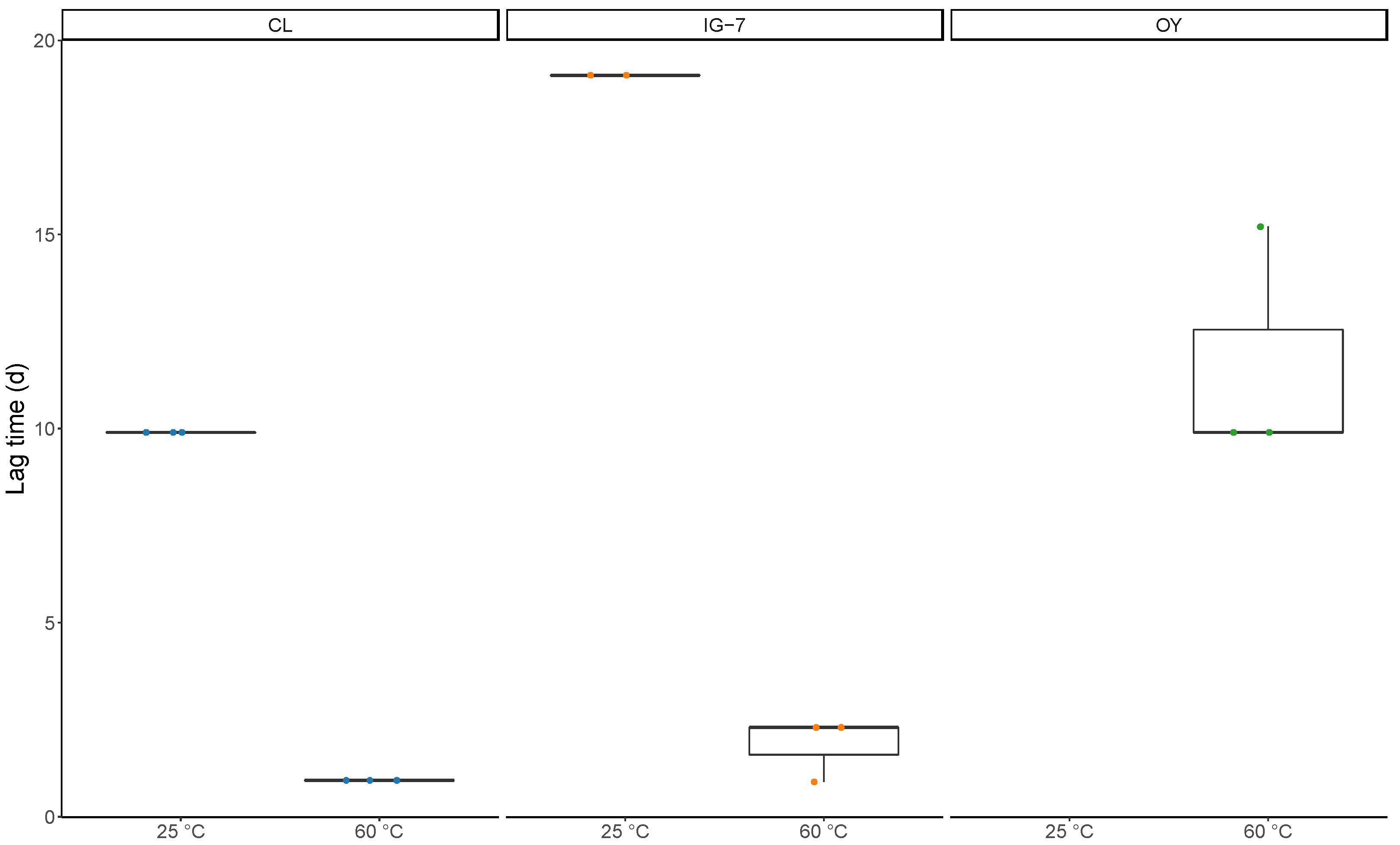

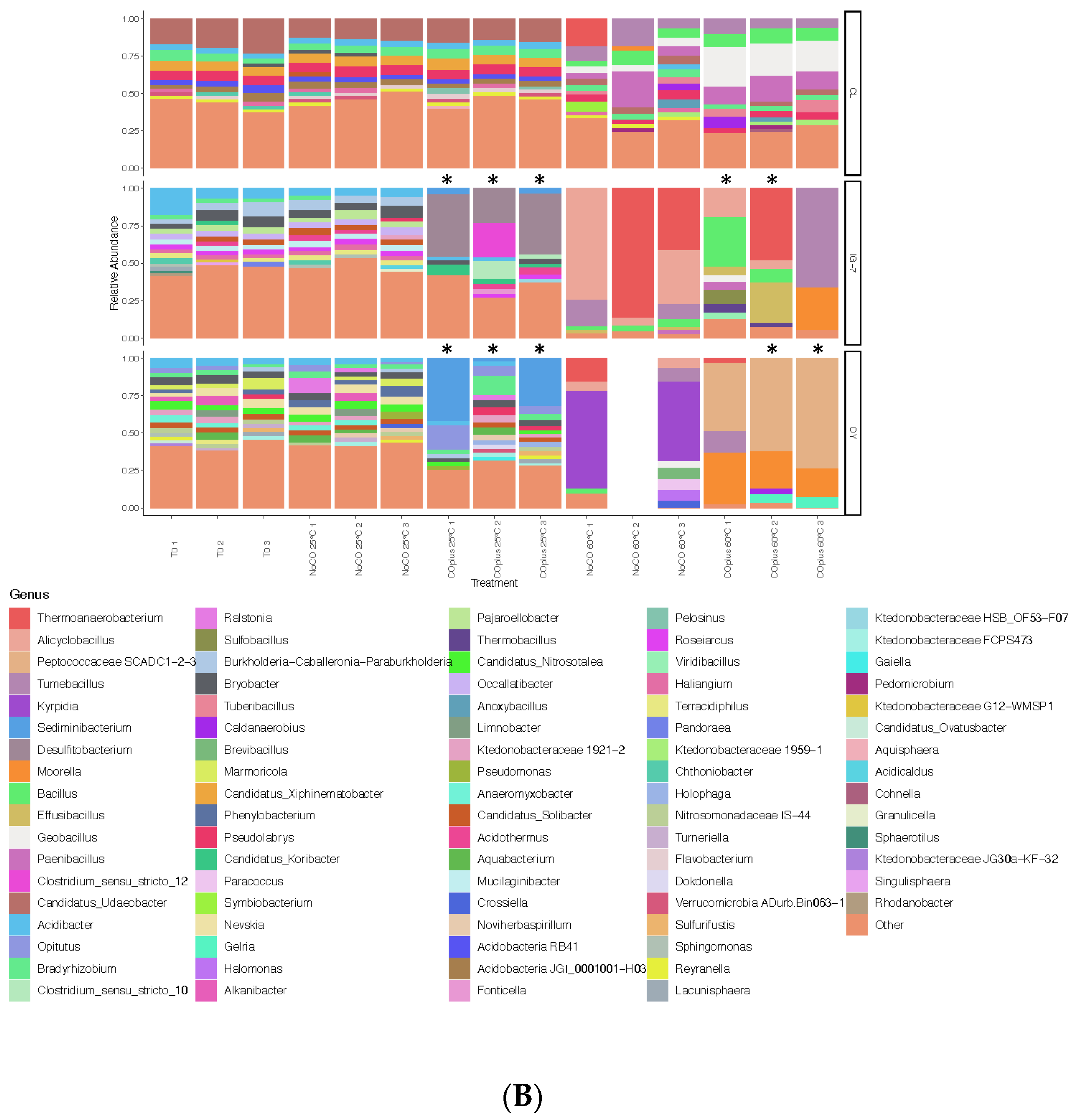

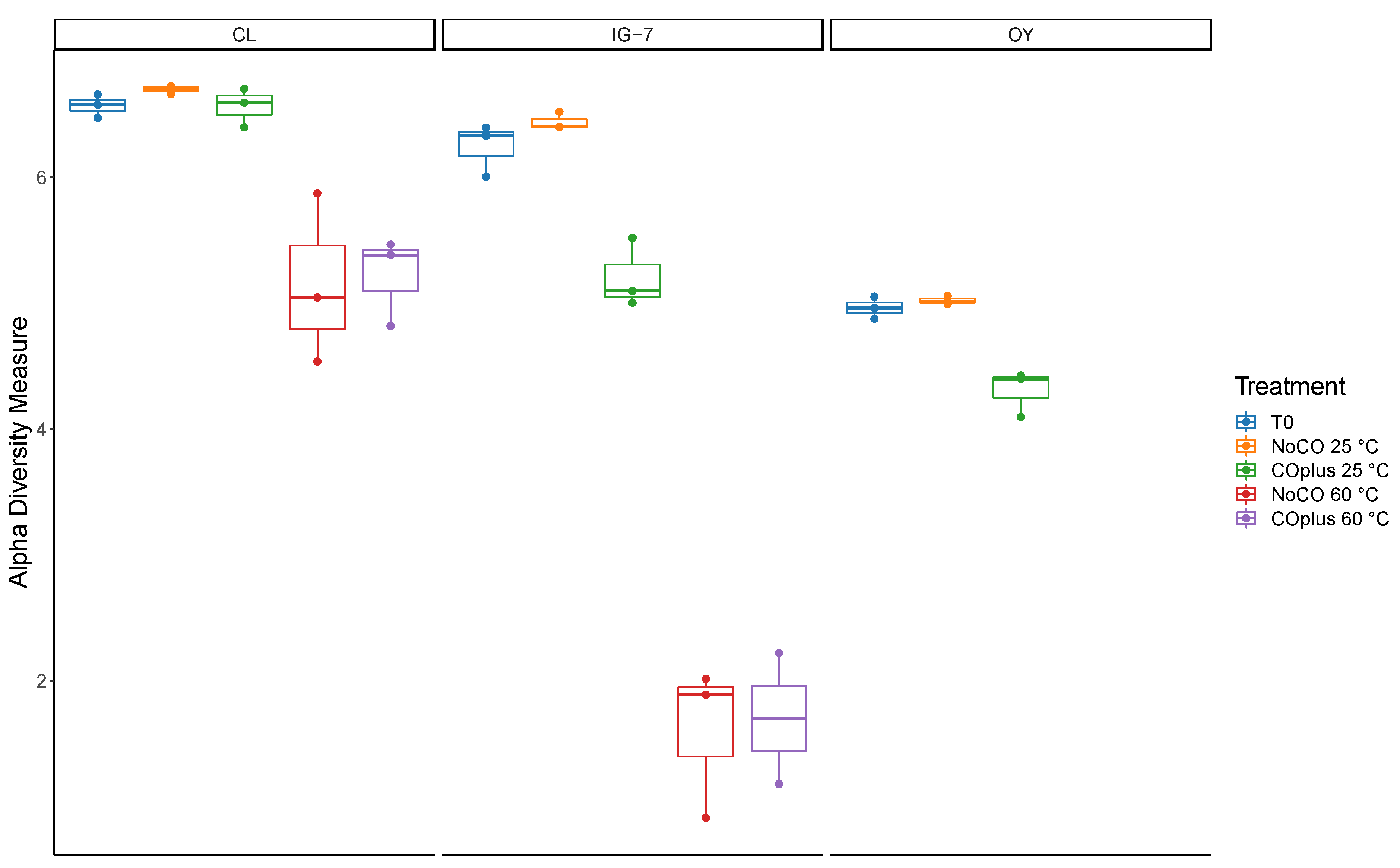

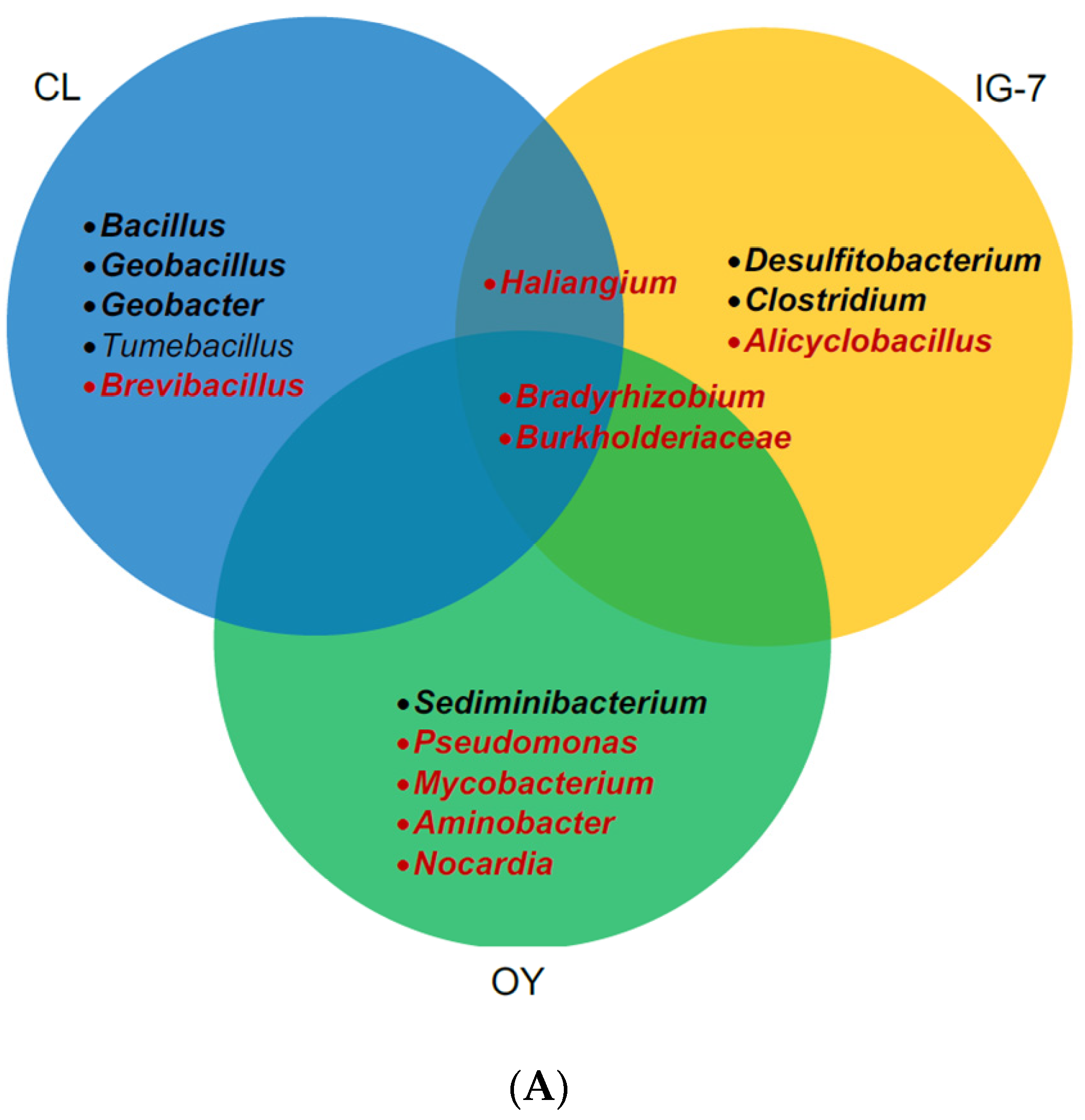
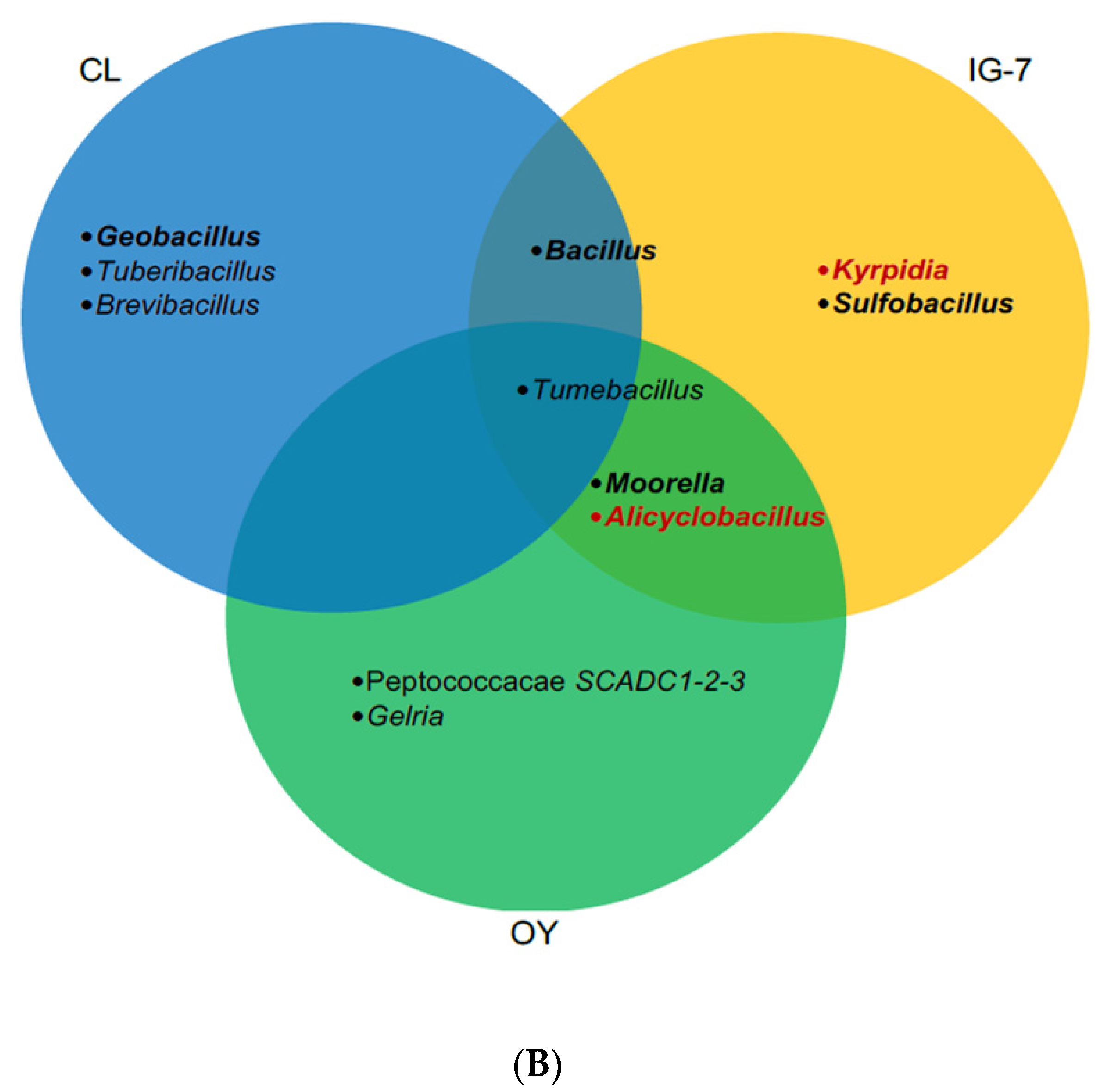
| Site | Age (Year) | Vegetation | pH | OM% | 10 ppm CO | 25% CO | ||
|---|---|---|---|---|---|---|---|---|
| Aerobic | Anaerobic | 25 °C | 60 °C | |||||
| Trial 1 | ||||||||
| CL | ca. 800 | Forest | 5.2 ± 0.05 | 21.8 ± 0.5 | 0.8 ± 0.1 | 0.8 ± 0.1 | 24.5 ± 1.5 | 154.5 ± 6.0 |
| IG-7 | 18 | Grass | 4.5 ± 0.03 | 3.1 ± 0.4 | 0.1± 0.02 | 0.1 ± 0.01 | 4.0 ± 2.0 | 31.7 ± 10.7 |
| OY | 18 | Mixed, sparse | 4.8 ± 0.05 | 1.7 ± 0.1 | 0.07 ± 0.01 | 0.04 ± 0.01 | 0 | 5.8 ± 0.8 |
| Trial 2 | ||||||||
| CL | -- | -- | -- | -- | NM | NM | 20.3 ± 4.8 | 36.1 ± 0.6 |
| IG-7 | -- | -- | -- | -- | NM | NM | 0 | 6.1 ± 6.1 |
| OY | -- | -- | -- | -- | NM | NM | 0 | 3.5 ± 3.5 |
| Site | CO Uptake Rate (µmol gdw−1 d−1) | ||||
|---|---|---|---|---|---|
| 0.1% CO | 1% CO | 5% CO | 15% CO | 25% CO | |
| OY 25 °C | 0.07 ± 0.002 | ND | ND | ND | ND |
| OY 60 °C | 0.19 ± 0.01 | 0.37 ± 0.02 | ND | ND | ND |
| IG-7 25 °C | 0.21 ± 0.06 | 0.34 ± 0.01 | ND | ND | ND |
Publisher’s Note: MDPI stays neutral with regard to jurisdictional claims in published maps and institutional affiliations. |
© 2020 by the authors. Licensee MDPI, Basel, Switzerland. This article is an open access article distributed under the terms and conditions of the Creative Commons Attribution (CC BY) license (http://creativecommons.org/licenses/by/4.0/).
Share and Cite
DePoy, A.N.; King, G.M.; Ohta, H. Anaerobic Carbon Monoxide Uptake by Microbial Communities in Volcanic Deposits at Different Stages of Successional Development on O-yama Volcano, Miyake-jima, Japan. Microorganisms 2021, 9, 12. https://doi.org/10.3390/microorganisms9010012
DePoy AN, King GM, Ohta H. Anaerobic Carbon Monoxide Uptake by Microbial Communities in Volcanic Deposits at Different Stages of Successional Development on O-yama Volcano, Miyake-jima, Japan. Microorganisms. 2021; 9(1):12. https://doi.org/10.3390/microorganisms9010012
Chicago/Turabian StyleDePoy, Amber N., Gary M. King, and Hiroyuki Ohta. 2021. "Anaerobic Carbon Monoxide Uptake by Microbial Communities in Volcanic Deposits at Different Stages of Successional Development on O-yama Volcano, Miyake-jima, Japan" Microorganisms 9, no. 1: 12. https://doi.org/10.3390/microorganisms9010012
APA StyleDePoy, A. N., King, G. M., & Ohta, H. (2021). Anaerobic Carbon Monoxide Uptake by Microbial Communities in Volcanic Deposits at Different Stages of Successional Development on O-yama Volcano, Miyake-jima, Japan. Microorganisms, 9(1), 12. https://doi.org/10.3390/microorganisms9010012




